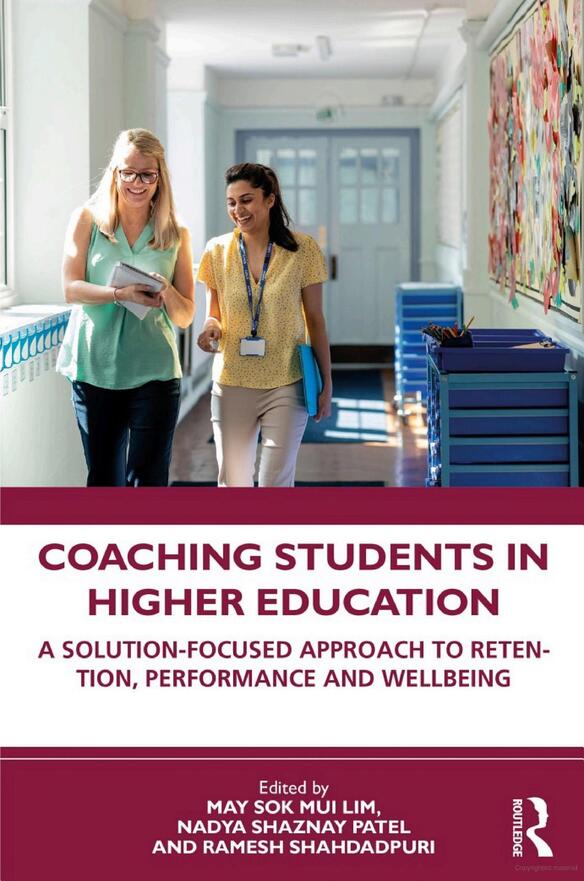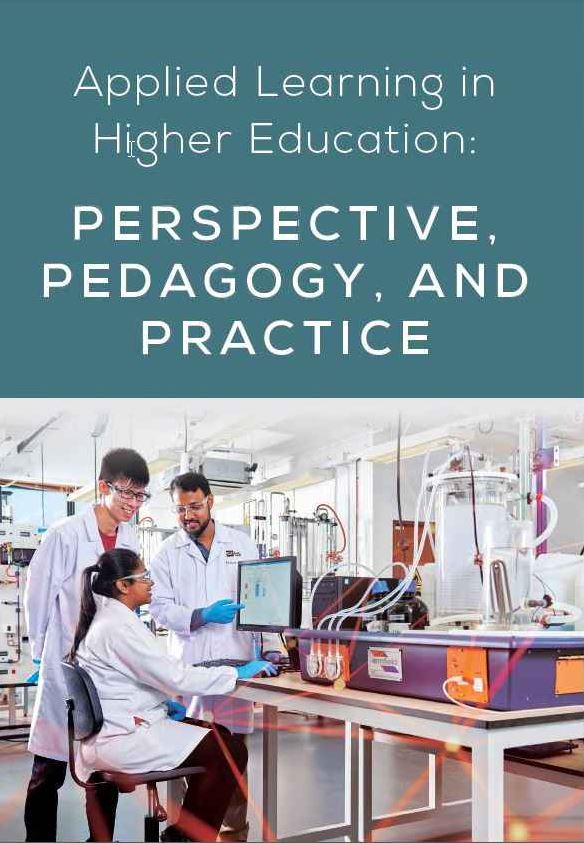
Publications
Highlighted Publication

Coaching Students in Higher Education: A Solution-Focused Approach to Retention, Performance and Wellbeing
Routledge, 2024
May Sok Mui Lim, Nadya Shaznay Patel, Ramesh Shahdadpuri
This practical guide for educators in higher education encourages readers to ask effective coaching questions and apply relevant coaching techniques to empower and engage students to grow and perform at their best.
Filled with authentic examples and handy tips, the book takes readers from the ‘how to’ of coaching, through the practicalities, challenges and honing of existing skills and new capabilities. The authors recognise that in educators’ daily encounters and interactions with students, there are many timely coachable moments for authentic learning. These opportunities can enable students to learn beyond what is squarely in their curriculum and develop their own pathways to become work-ready graduates. Through coaching, educators help students discover more about themselves while guiding them to innovate and generate solutions to perceived and real-world problems. This guide offers in depth discussions along with tools and tips to provide invaluable guidance for educators to get acquainted with the key skills needed to coach students for success in various academic and professional contexts. The content covers multiple varied scenarios, from classrooms and assignments, to internships and group work, and highlights various coaching opportunities with practical strategies.
This is a resourceful text for educators, teachers and professionals working in higher education and learning institutions. It provides training material for institutions that want to conduct faculty development programmes to prepare educators for effective coaching conversations in their universities.

Applied Learning in Higher Education: Perspective, Pedagogy, and Practice
Informing Science, 2020
Sok Mui Lim, Yong Lim Foo, Han Tong Loh, Xudong Deng
Today, “all institutions of higher education almost everywhere in the world have been influenced by the concept of globalisation. The resulting policy changes in each nation-state have, of course, reflected the degree of the impact of globalisation on the country, hence the changes in higher education.” (Banya, 2005, p.147). This points to globalisation shaping knowledge production as well as the spread of intentional and continuous waves of innovation. The effects of globalisation on education can be seen through a) the changing paradigm from a closed system to a more open system, and b) the changing approach from a teacher-centred learning environment to that of a learner-centred environment. This changing approach culminates in the broader ideas of ‘applied learning’ through a) a productive view of learning versus the reproductive view of learning, b) constructivist versus behaviourist, c) learning facilitation versus teaching, and d) process-based assessment versus outcome-based assessment (Rudic, 2016).
All Publications
- The implementation of chatbot-mediated immediacy for synchronous communication in an online chemistry courseSpringer, 2023Jamil Jasin, He Tong Ng, Indriyati Atmosukarto, Prasad Iyer, Faiezin Osman, Peng Yu Kelly Wong, Wean Sin Cheow, Ching Yee Pua
Low student engagement and motivation in online classes are well-known issues many universities face, especially with distance education during the COVID-19 pandemic. The online environment makes it even harder for teachers to connect with their students through traditional verbal and nonverbal behaviours, further decreasing engagement. Yet, addressing such problems with 24/7 synchronous communication is overly demanding for faculty. This paper details an automated Question-Answering chatbot system trained in synchronous communication and instructor immediacy techniques to determine its suitability and effectiveness in attending to students undergoing an online Chemistry course. The chatbot is part of a new wave of affective focused chatbots that can benefit students’ learning process by connecting with them on a relatively more humanlike level. As part of the pilot study in the development of this chatbot, qualitative interviews and self-report data capturing student-chatbot interactions, experiences and opinions have been collected from 12 students in a Singaporean university. Thematic analysis was then employed to consolidate these findings. The results support the chatbot’s ability to display several communication immediacy techniques well, on top of responding to students at any time of the day. Having a private conversation with the chatbot also meant that the students could fully focus their attention and ask more questions to aid their learning. Improvements were suggested, in relation to the chatbot’s word detection and accuracy, accompanied by a framework to develop communication immediacy mechanics in future chatbots. Our findings support the potential of this chatbot, once modified, to be used in a similar online setting.
- Take care over sharing: guiding student teams on collaborationTimes Higher Education, 2023Xiao-Feng Kenan Kok
Effective teamwork requires shared understanding, goals and responsibility over a task. Kenan Kok Xiao-Feng explains how to guide students in working collectively.
- Three steps to accepting failure: recognize, embrace and enculturateTimes Higher Education, 2023Xiao-Feng Kenan Kok, Oran Zane Devilly
Many fail to see the blood, sweat and tears that often go into both successes and failures. We must learn how to celebrate the process as well as the outcome.
- Understanding user experiences across VR walking-in-place locomotion methodsCHI Conference on Human Factors in Computing Systems, 2022Chek Tien Tan, Leon Cewei Foo, Adriel Yeo, Jeannie Su Ann Lee, Edmund Wan, Xiao-Feng Kenan Kok, Megani Rajendran
Navigating large-scale virtual spaces is a major challenge in Virtual Reality (VR) applications due to real-world spatial limitations. Walking-in-place (WIP) locomotion solutions may provide a natural approach for VR use cases that require locomotion to share similar qualities with walking in real-life. However, there is limited knowledge on the range of experiences across common WIP methods to inform the design of usable WIP solutions using consumer-accessible components. This paper contributes to this knowledge via a user study with 40 participants that experienced several easy-to-setup WIP methods in a VR commuting simulation. A nuanced understanding of cybersickness and exertion relationships and walking affordances based on different tracker setups were among the findings derived from a corroborated analysis of think-aloud, interview, and observational data, supplemented with self-reports of VR sickness, presence and flow. Practical design insights were then constructed along the dimensions of cybersickness, affordances, space and user interfaces.
- Human influence on energy efficiency: A story based on an innovation project with a hospital in SingaporeISSUU Digital Publishing, 2023Shi Li Chong, Jun Jie Lim, Teck Sheng Tan, Zi Liang Lam, Jia Yi Lim, Jevan Choo, Moshood Olawale Fadeyi
The human need or quest for comfort and convenience and lack or denial of awareness can contribute to energy wastage. This paper contains a written and video story of a research learning journey designed to develop the educational experience of Year 2 building services engineering students in developing a solution that can potentially be used to reduce the negative effect of human behaviour on energy consumption at Yishun Community Hospital, Singapore. The role of storytelling in developing the students’ critical and reflective thinking needed to induce learning to form an educational experience, i.e., knowledge, understanding, and practical and communication skills, was examined. Students went through classroom training to give them the background knowledge and understanding required to fulfill the energy efficiency innovation project requirements. The reported educational experience gained from the learning journey is documented in this paper. This paper reports a method of developing human capability for energy-efficiency agenda achievement. It also reports an approach for contributing to the educational experience needed to prepare undergraduate students to solve real-life problems and be job ready upon graduation.
- Human influence on water efficiency: A story based on an innovation project with a hospital in SingaporeISSUU Digital Publishing, 2023Sharleen Low, Casimir Chian, Zhen Xuan Low, Sherman Low, Tine Nyiyaza, Moshood Olawale Fadeyi
Water wastage caused by human behaviour can be largely due to human need or quest for comfort and convenience and lack or denial of awareness. Year 2 building services engineering students were tasked to conduct research that will inform the development of a solution that can potentially be used to reduce the negative effect of human behaviour on water consumption at Mouth Elizabeth Hospital, Singapore. The students were also required to write a story and made of video story based on the research to document and demonstrate how the research learning journey has developed their educational experience. The role of storytelling in developing the students’ critical and reflective thinking needed to induce learning to form an educational experience, i.e., knowledge, understanding, and practical and communication skills, was examined. The students developed the background knowledge and understanding required to fulfill the water efficiency innovation project requirement. A method of developing human capability for water-efficiency agenda achievement and providing the educational experience undergraduate students need in their journey to being job ready upon graduation is reported in this paper.